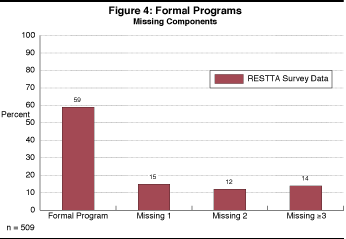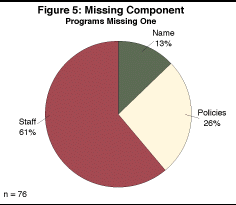|
"Formal" and "Informal" Restitution An important issue is the extent to which juvenile courts and judges see restitution as "formal," and hence an important sanction in its own right, or as an "add-on" to other conditions of probation. There is a large difference in effectiveness between the two approaches; a study conducted as part of the national evaluation of the Juvenile Restitution Initiative showed that a formal approach to restitution resulted in much higher completion rates and much lower recidivism than an informal approach (Schneider and Schneider, 1984). In the 1991 RESTTA survey, a program was considered formal if it had a name, at least one full-time staff person solely responsible for enforcing restitution orders, and a written set of policies and procedures. Based on this definition, approximately 60 percent, or about 330 of the programs surveyed, are considered formal (see Figure 4). Fifteen percent of the programs missed only one of the three components of the definition; 12 percent missed two; and 14 percent lacked all three. Figure 5 shows which component is most likely to be missing. Of the programs lacking only one component, 61 percent are missing (not surprisingly) a full-time staff person. Written policies and procedures are lacking in 26 percent of those missing only one component, while 13 percent do not have a name.   The content of the policies and procedures manual is a useful indicator of management and administrative practices. Programs surveyed were provided with a list of items drawn from the RESTTA Juvenile Restitution Management Audit (Thornton, Rubin, and Henderson, 1989) and were asked to check the items included in their manuals. The results, ranked in order of frequency, are displayed in Table 2. Although it is encouraging to note that about half of all the formal programs contain at least two-thirds of these items in their policies and procedures manuals, there are a few surprises. For example, only 81 of the programs appear to have a written policy on the amount of wages that may be retained by an offender working in a restitution-related job. Because many programs allow offenders to keep a portion of their wages for expenses or as an incentive to keep working and paying restitution, policies regulating this practice were thought to be more common. In addition to policies and procedures manuals, many programs provide their staff with other written materials to help them function more efficiently. A list of auxiliary management tools and the number of programs that claim to utilize them are presented in rank order in Table 3. Procedures for determining community service and financial restitution rank at or near the top of the list, checked, with 258 and 202 programs, respectively. The fact that many programs have community service sentencing matrices is due, most likely, to the large number of community service programs (see below). Written procedures for determining community service hours and amounts of financial restitution have long been promoted by the RESTTA project, which included examples and directions for use in the Guide to Juvenile Restitution (Schneider, 1985). Other frequently noted items had to do with insurance, employee benefits, and informational or public relations materials. The extent to which restitution is integrated into normal court practices is reflected, at least in part, by the location of the program. Prior to the restitution initiative, programs were usually located outside the court and the probation department: In Oklahoma City, Oklahoma, for example, the program was part of Victim Services; in Quincy, Massachusetts, the Earn-It Program was separated from probation and located, perhaps symbolically, in a trailer parked in the courthouse lot. Of the programs funded by the initiative, about 40 percent were located outside the court or probation departments (Schneider et al., 1982), and 31 percent of the programs included in the 1987 National Directory were administered by agencies other than the court or probation department (Warner and Burke, 1987). Over the years there has been a dramatic shift in the location of restitution programs. As shown in Table 4, 75 percent of the programs are located in probation departments, with more than half (56 percent) in local departments administered by the court. About 10 percent of the programs are located within other kinds of governmental agencies, and 15 percent are outside governmental authority altogether. The incorporation of restitution programs within the court and probation departments reflects the institutionalization of restitution as a practice, and the legitimacy of restitution as a sanction.
|